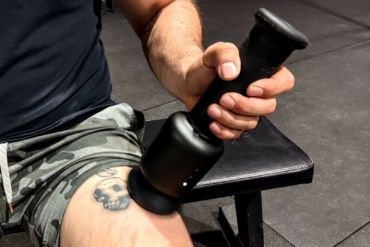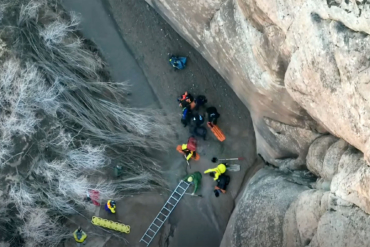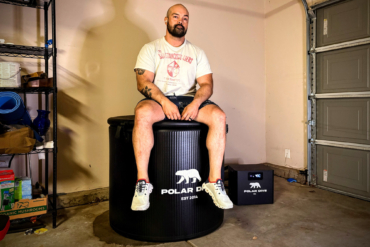Don’t let hidden trail hazards trip you up. Prevent and treat sprains and strains by following these steps.

It could happen with an awkward fall while climbing at the gym. Or hiking over roots, rocks, and trail divots obscured by leaves. Ankle strains and sprains put you out of commission and can be a real bummer. So here are some quick tips to prevent ankle injuries.
What is a Sprained Ankle?
The ankle is a “hinge” joint bridging the foot and lower leg. Lateral and medial ligaments secure the leg bones to the talus bone in the foot, keeping the ankle aligned to flex and extend.
A sprain or strain occurs when the joint rolls medially or laterally, stretching or tearing the ligaments that secure the ankle in its normal range of motion.
How Sprained Ankles Happen
Sprains and strains are most common when the foot is in plantar flexion. In layman’s terms, that’s when your ankle bends forward and your toes point down. When the toes point this way, the foot is less stable.
Furthermore, the lateral (outside) ligament is the weaker of the two ligaments strapping the ankle. Caught off guard by a rogue root or stone, the ankle can more easily roll beyond the normal range of motion, stretching or tearing the lateral ligament.
Sprained Ankle Symptoms
Did you feel or hear a “pop” when you rolled the ankle? That’s often the tell-tale sound of a sprained or torn ligament, or possibly an avulsion fracture. Afterward, the ankle will be painful to stand on and tender to the touch. It might be swollen, bruised, feel unstable to stand on, or have restricted range of motion.
Fractures and sprains often present very similar symptoms, so get it checked out, especially if the ankle feels unstable.
How to Prevent a Sprained Ankle
While not entirely avoidable, there are steps you can take to protect your ankle from sprains. Strengthening the muscles of the foot and leg through calf raises, foot flexion, and eversion (outward) and inversion (inward) exercises will embolden a citadel around the ankle.
If you’re an avid backpacker, consider upgrading to lighter gear to decrease the load in the pack. New materials and high-quality down fill can considerably cut bulk and weight, allowing you to be more nimble on your feat.
Wear high-top adventure shoes or the tried-and-true lace-up hiking boot. The added height will help support the ankle, particularly when carrying a heavy pack.
If you don’t own a pair, get yourself some trekking poles; four legs are better than two. And if hiking in the dark, bring a headlamp so you can identify any hazards.
Like any exercise, it’s good practice to warm up the muscles before heading out on the trail. Limber up, stretch the calves, and start slow.
And finally, watch your step. I was told at an early age to “step over what you can and walk around what you can’t step over.”
Sprained Ankle Treatment
If you roll an ankle and experience the symptoms above, remember “RICE.”
- Rest. Take a break. Even if it’s not serious, one fall can easily lead to another. Rest will allow the initial pain to subside and the mind to regroup.
- Ice. In snow country? Pack snow in a water bladder and lay it over the ankle. Too low for snow? Find a cold stream to rest the ankle in. Ice the ankle for 15–20 minutes, then remove the ice and let the ankle warm up. Don’t ice for longer than 20 minutes, as it could cause more damage than good. Icing reduces swelling and dulls the pain.
- Compression. Remove the shoe or boot and wrap the ankle with an ACE bandage, bandana, or t-shirt. This reduces swelling and adds some stability when hiking out.
- Elevation. Lie down and elevate the ankle above the heart. This will prevent fluids from pooling around the injured ankle. Stay off your feet for 2–3 hours.
Repeat the icing cycle every hour for 2–4 hours.
It should be noted that recent research has indicated that there maybe no therapeutic benefit to icing. While ice can reduce pain and inflammation, there is not reported increase in healing rate. But for short term mobility and extraction from the wild, icing is still your best bet.
If you have it, take ibuprofen (e.g., Advil). It counters the pain and reduces inflammation.
Gotta get out using human power? You’ll need to fashion some form of support to allow the ankle to bear weight on the walk out. A stirrup bandage can be taped under the foot and around the ankle. It doesn’t have to be fancy. You can even tape over the sock.

Don’t have tape? You can rig a U-shaped splint out of cardboard, tent poles, pad, or clothing. Wrap the splint under the foot and tape, or tie it securely around the ankle.
Go slow and use poles or a walking stick for additional support. If the pain is serious, see a physician when you return to town.
Worst-Case Scenario
I have a buddy who was playing hut games on a backcountry ski trip. His shenanigans landed him on a round can, forcing his ankle to roll abruptly. In pain, he hitched a ride out on a snowmobile. Over a month later, the pain still hadn’t subsided. He went in for an X-ray and found he didn’t just tear a ligament, he pulled off a piece of his foot bone in the process (an avulsion fracture).
One surgery and six months later—and 15 pounds heavier—he staggered back into shape just in time for the following ski season. So, if in doubt, take heed and get it checked out.







